Our planned visit of Salvador also entailed a ride on a funicular, as well as in a public elevator. Namely, the historic centre of Salvador is located on the top of a hill that rises steeply from the level of the port. Thus we first went down to the lower and flat parts of the city by the funicular. It was a little unusual that they did not charge anything for that, but, since nobody else asked any questions, neither did we. Later we realised that it was by pure chance that we found ourselves in Salvador right on the day of their major holiday and it was probably due to the holiday that the funicular ride was free of charge.
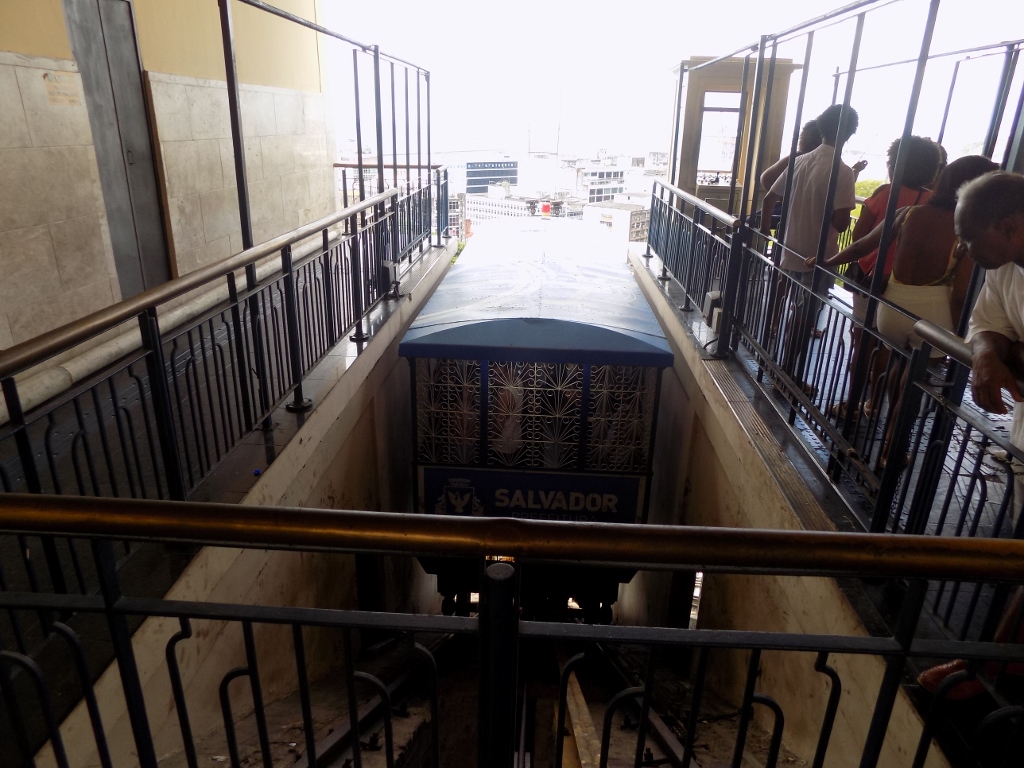 Waiting in line to go down by the funicular
Waiting in line to go down by the funicular
Although it is only the Upper City that is on the World Heritage List, the buildings in the lower part are no less picturesque.
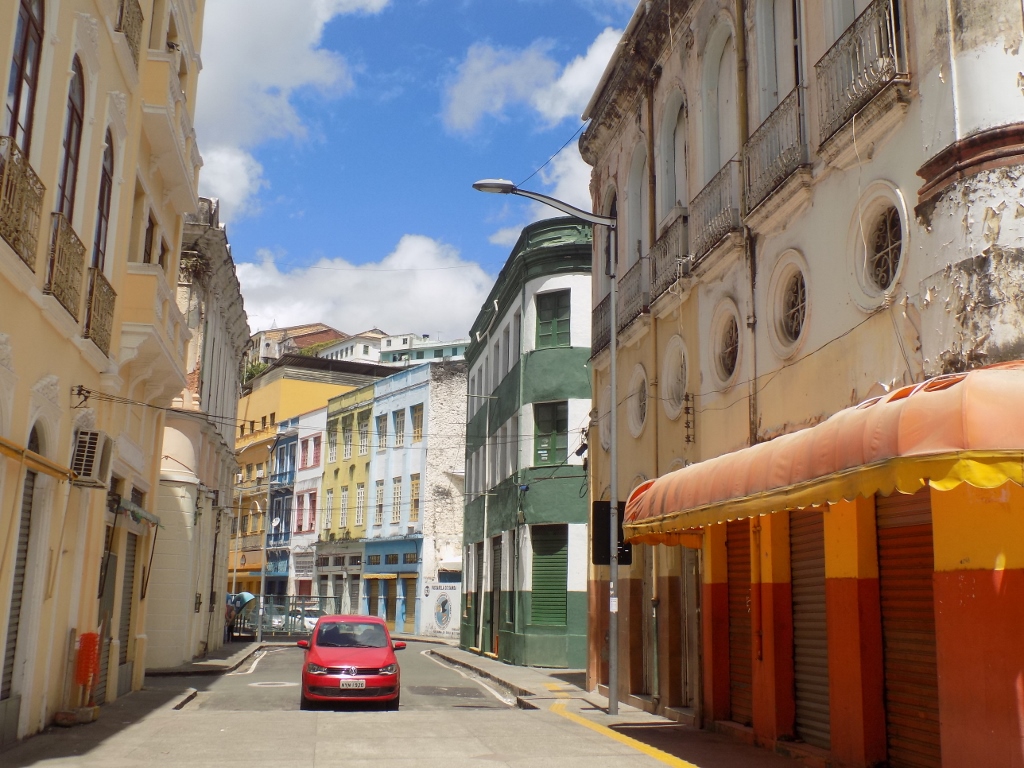 Flat parts of Salvador under the Upper City
Flat parts of Salvador under the Upper City
From the exit from the funicular, we headed straight along the street with an idea to get to the ocean, but then we heard (again) a lot of noise, so we turned into another street in order to see what this was about. Soon we came across the main procession in one spacious street, while a large number of people were standing or moving slowly on both sides.
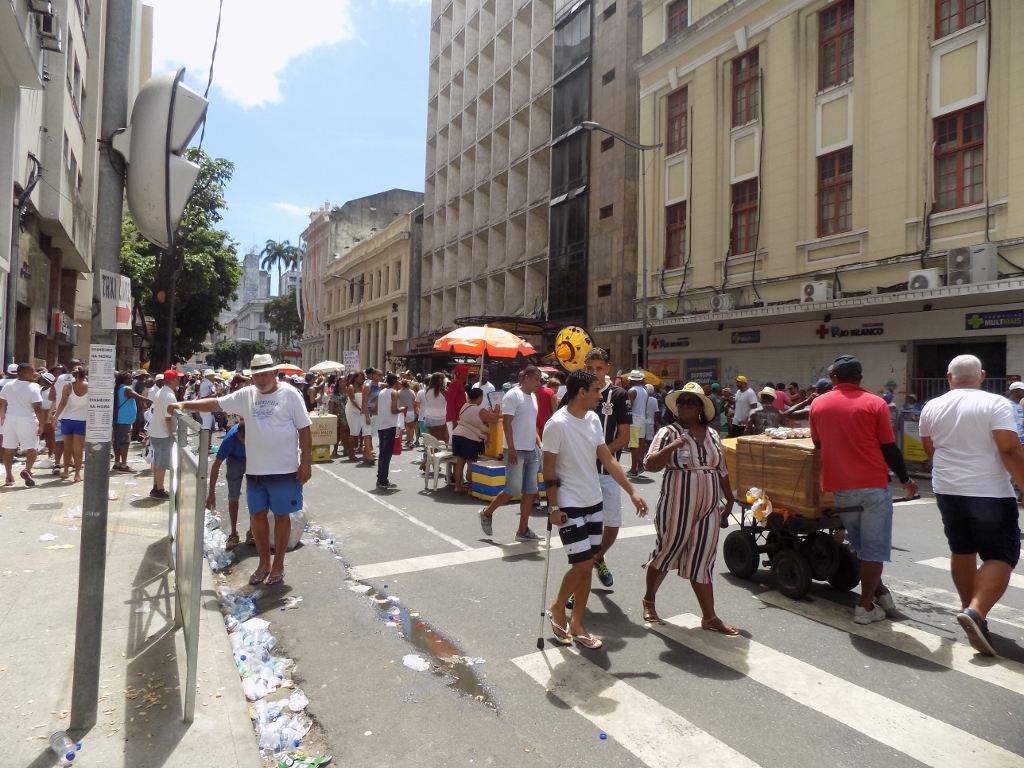 Something is going on in this street
Something is going on in this street
In fact, when the two of us arrived, the procession was standing, but the music did not stop nor the stomping of numerous people who followed the vehicles that carried musicians.
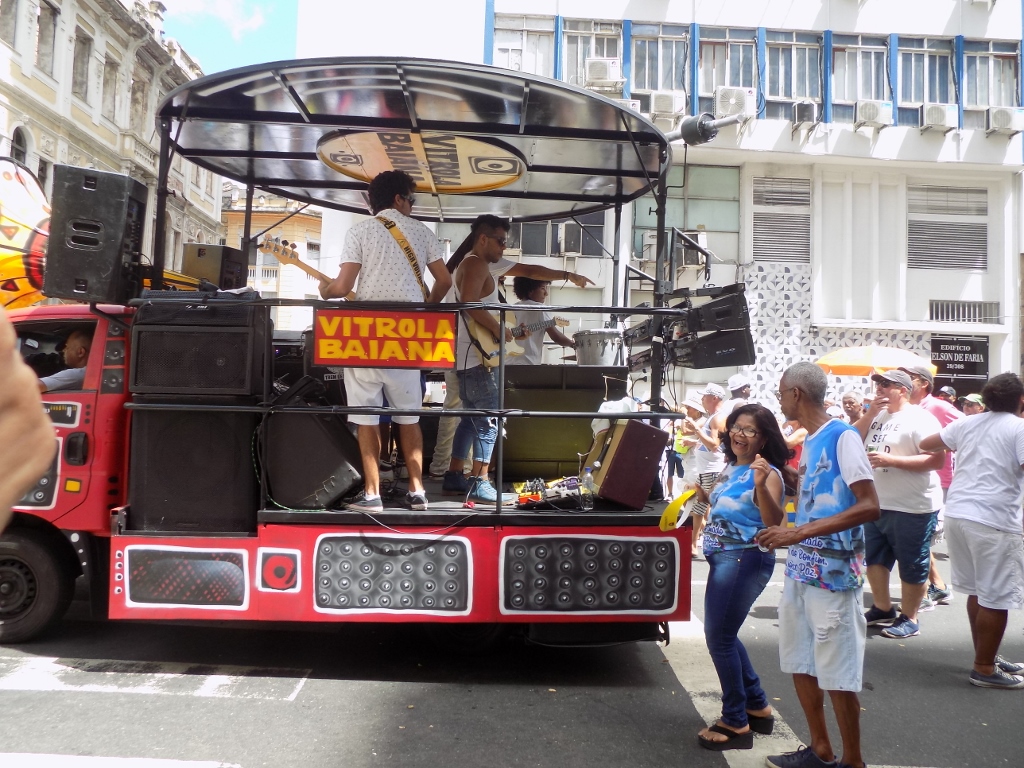 It is easy to dance well to the good music
It is easy to dance well to the good music
The two of us had no idea what this was all about, but we certainly did not mind it. Quite the contrary, we rather enjoyed the experience and along the way we each also had a skewer-full of grilled meat. It was very tasty.
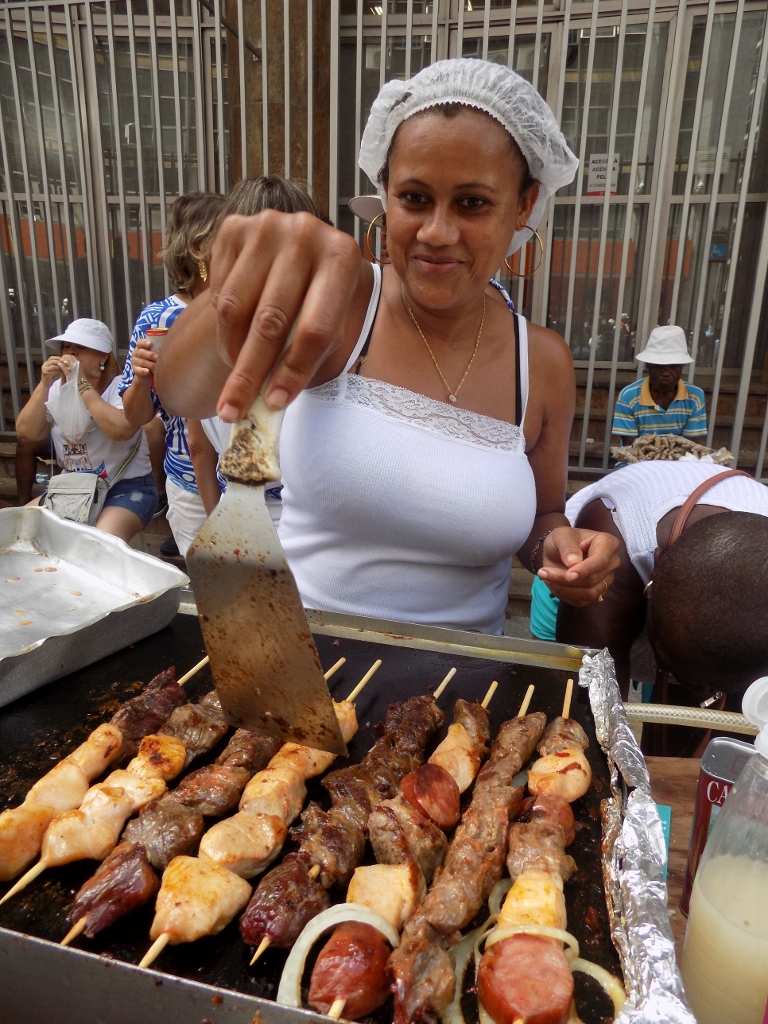 Our snacks are being prepared
Our snacks are being prepared
Of course, photos alone cannot fully convey the experience, so here is a short video clip. You may get a slight headache on account of my poor filming, but hang on.
We watched the events for a while, although we had absolutely no clue what this was all about (we just knew it was not the carnival) and then we turned again into one of the side streets since we wanted to go to the Church of Our Lord of Good End (Igreja de Nosso Senhor do Bonfim). The Church of St. Francis (Igreja de São Francisco) is certainly the most opulent one in all of Brazil, meaning Salvador as well, but the most famous church here was precisely the one we wanted to visit. It is a relatively simple church, built in the period from 1740 to 1772, but its significance does not lie in its architecture or artistic features. It is primarily the focal point of believers and pilgrims, since there are a lot of reported cases of people who were healed thanks to the Divine grace and this is the place where they then bring their votive offerings or ex-votos.
Since we had the time, we decided to go to see it and thought that afterwards we could return to the very south of the peninsula in which the centre of Salvador is located in order to see a beach and eat something there. This was what we thought not having the slightest idea about what this day was and what was happening in Salvador. And it was the third Thursday in January.
Thus we went to a bus stop, but it was hot, the bus was not coming and the two of us decided to take a taxi in order to get to the church of our choice.
At first everything went well and then the taxi got into an incredible jam and was mostly standing, rather than moving. I asked the driver if the church was far away and he said it was. What to do? We remained in the taxi and waited for it to take us where we wanted to go. We simply could not understand why there was such a traffic jam and thought that perhaps there was some horrible accident since we occasionally saw some police vehicles and an ambulance pass by, but even something like that would not explain such mess and jam as the one in which we found ourselves.
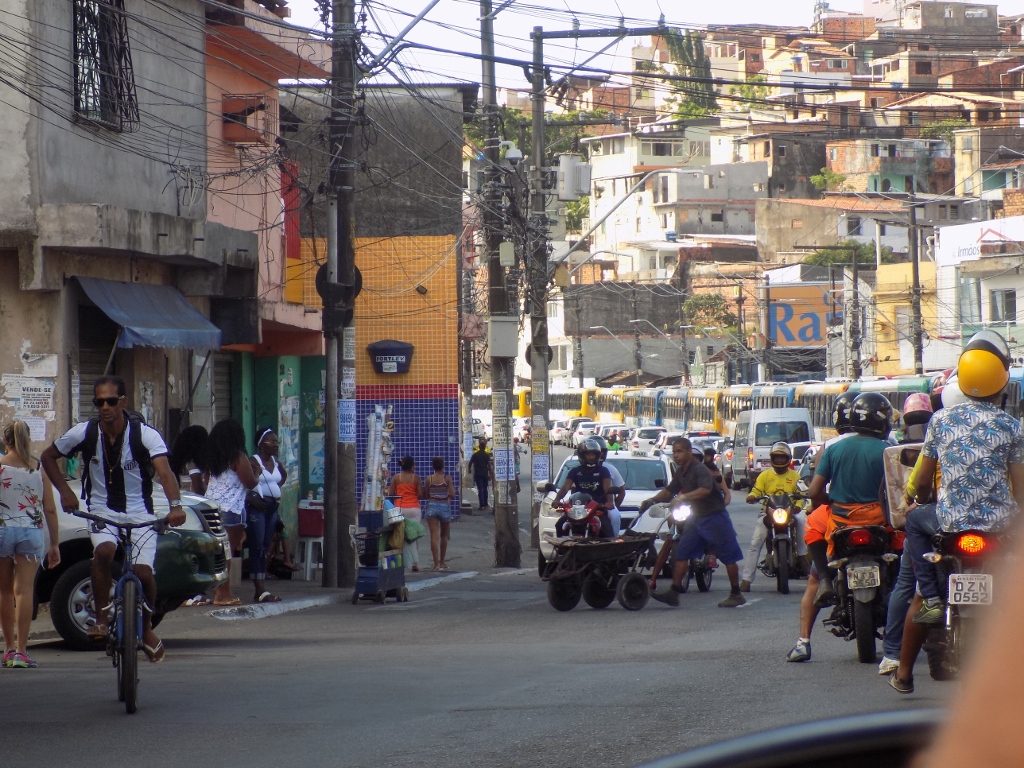 Photo taken from the taxi: note the city buses and the cars all standing on the right-hand side
Photo taken from the taxi: note the city buses and the cars all standing on the right-hand side
At some point, when the taxi eventually started to move and when it drove across a square, I saw a large notice-board and the inscription there finally explained what this was all about. It was the Festival of Good End (Festa do Bonfim), the second-largest celebration in the city after the carnival. Still, despite the continuous traffic jam, we were not aware of the right proportion of the celebration of this holiday until the taxi brought us to a small square from where it could no longer go forward and the taxi-driver just told us to walk straight.
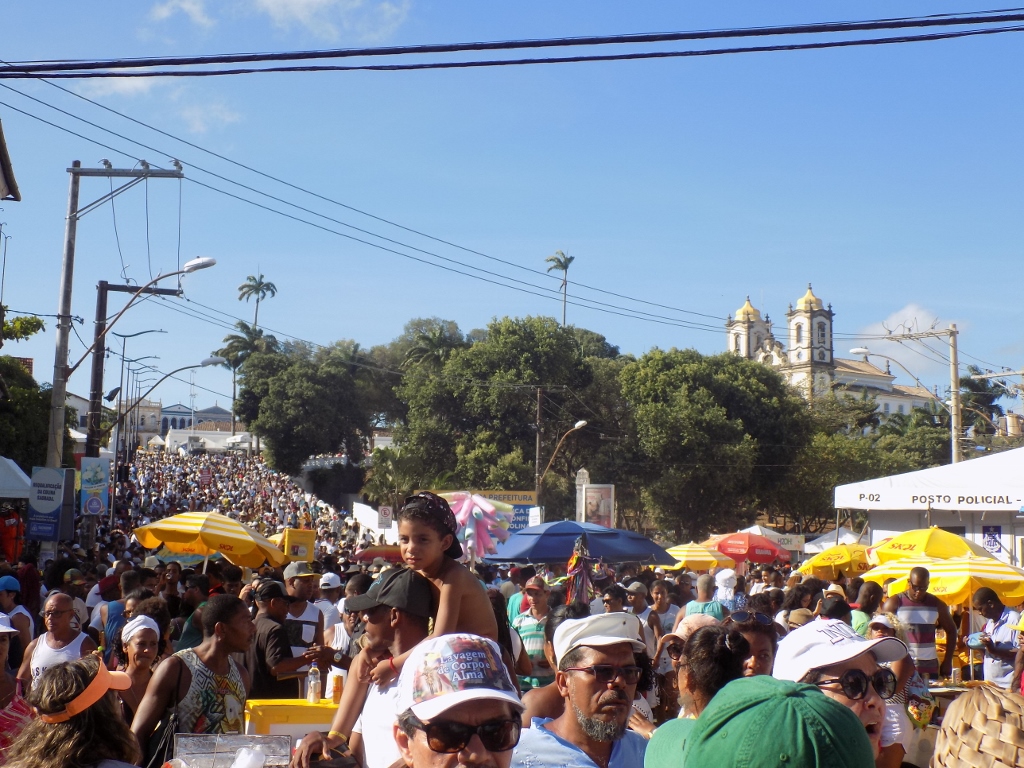 Festival and the Church of Our Lord of Good End (Igreja de Nosso Senhor do Bonfim) on the top of the hill
Festival and the Church of Our Lord of Good End (Igreja de Nosso Senhor do Bonfim) on the top of the hill
So now, let me explain what this is about, which I actually realised only during the event or later. Since this is the most important church in Salvador that helps with miraculous healings, the church and the whole “Good End” (Bonfim) concept have become extremely popular and the main festivity, the Celebration of Good End (Festa do Bonfim), linked to the church and the Good Eng take place every year on the third Thursday in January. It is then that the pilgrims and the faithful start to walk from the Basilica of the Immaculate Conception (Basílica Nossa Senhora da Conceição da Praia) that is located in the lower part of the centre of Salvador and then in the form of a procession they cover the distance of 8 km to the church. This procession was in fact what Sneža and I came across when we left the funicular earlier, but the joyfulness and the music did not create in us any association linked to a religious celebration.
Let me clarify – when the Portuguese brought African slaves to Brazil, the latter were prohibited from celebrating their own gods and they had to follow the religion of their masters. The resourceful, believing slaves did manage, however, to find the way to bring their own gods, as well as the manner of celebrating these gods, into the new set of beliefs they were forced to follow. For this reason, these celebrations that are absolutely and unquestionably linked to religious themes may appear unusual to traditionally oriented or clueless tourists, as the two of us were (before we understood what this was about). By the way, the Portuguese insisted that their slaves celebrated the Portuguese god, but they did not allow them into the churches used by the masters and for this reason there are often churches (e.g., in Ouro Preto and here in Salvador) where it is stressed that they were built precisely and only for the slaves.
Walking in the direction of the church we passed among a huge number of people and there we definitely realised that the white colour of clothes, especially when combined with blue, was something that constituted almost a uniform linked to this celebration. Now I also comprehended that those young people of the very early in the morning who beat on their drums and shouted to one another in front of our flat and were getting ready for some party were also dressed in white clothes and I was sure that they were a part of the celebration of Good End, too.
One of the most interesting “costumes” we came across were worn only by men and as we found out later these were members of an organisation called the Children of Gandhi (Filhos de Gandhy). The organisation was founded in 1949 and it has trade-union roots, while it is inspired by the principles of nonviolence and peace promoted by Mahatma Gandhi.
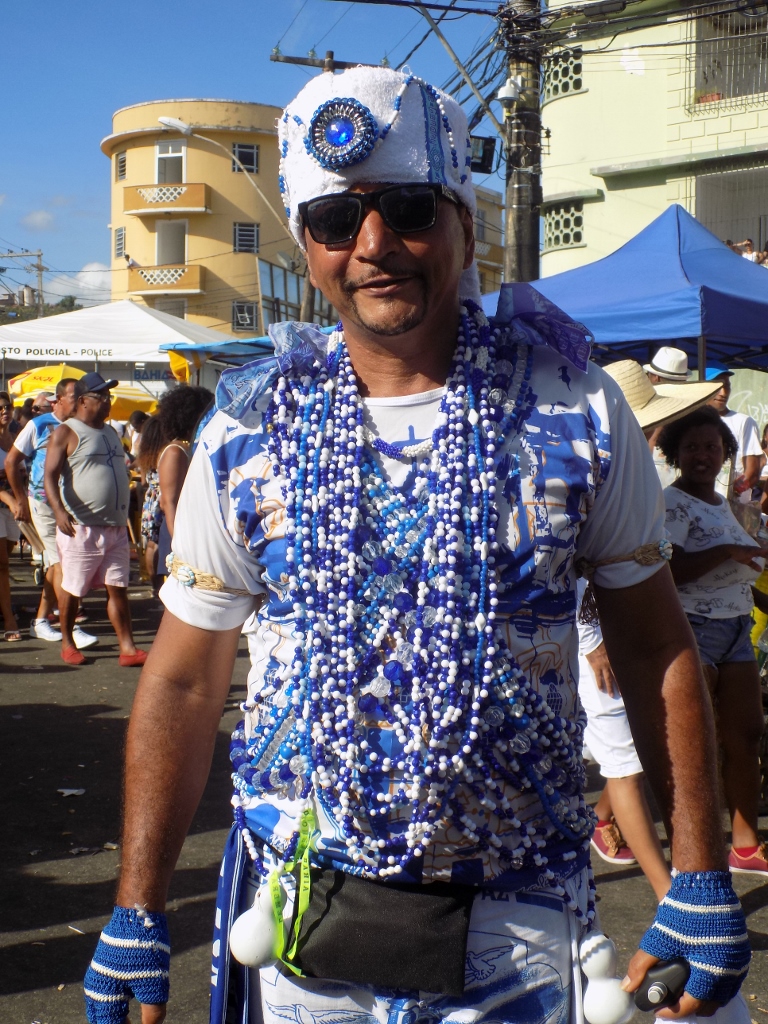 Member of the organisation Children of Gandhi
Member of the organisation Children of Gandhi
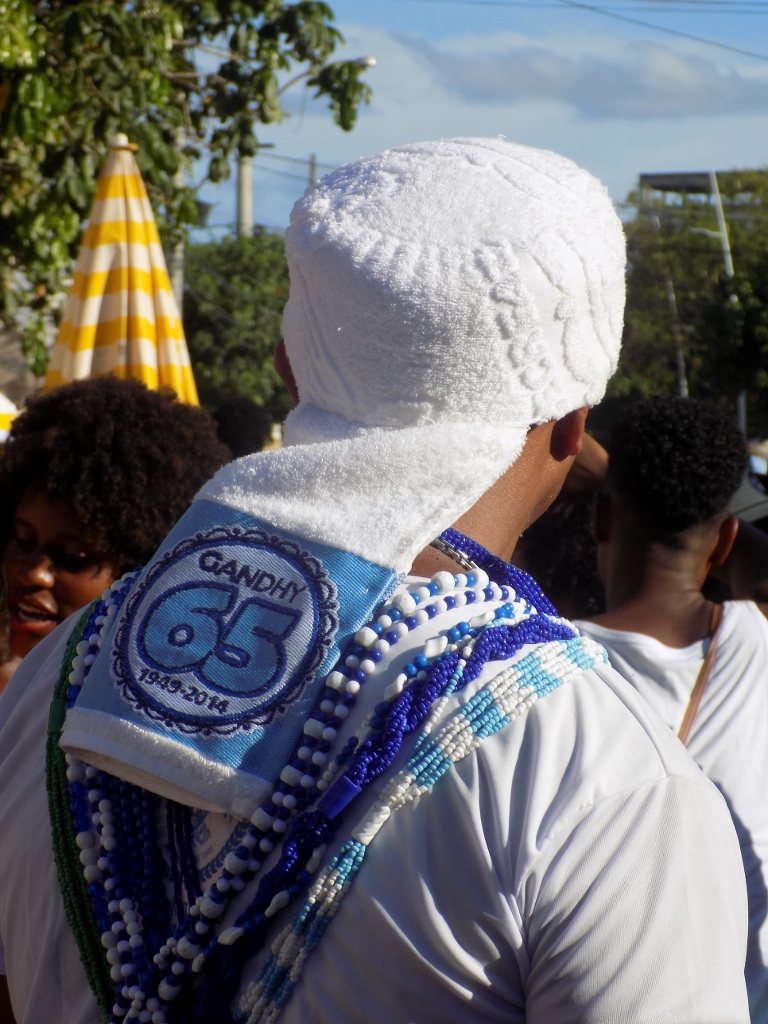 A hat worn by the members of the organisation “Children of Gandhi”
A hat worn by the members of the organisation “Children of Gandhi”
Of course, there were also other even more picturesque individuals, but it was not possible to take photos of them all. On the other hand, I did manage to take a photo of a very interesting cap made of soft drink can tabs.
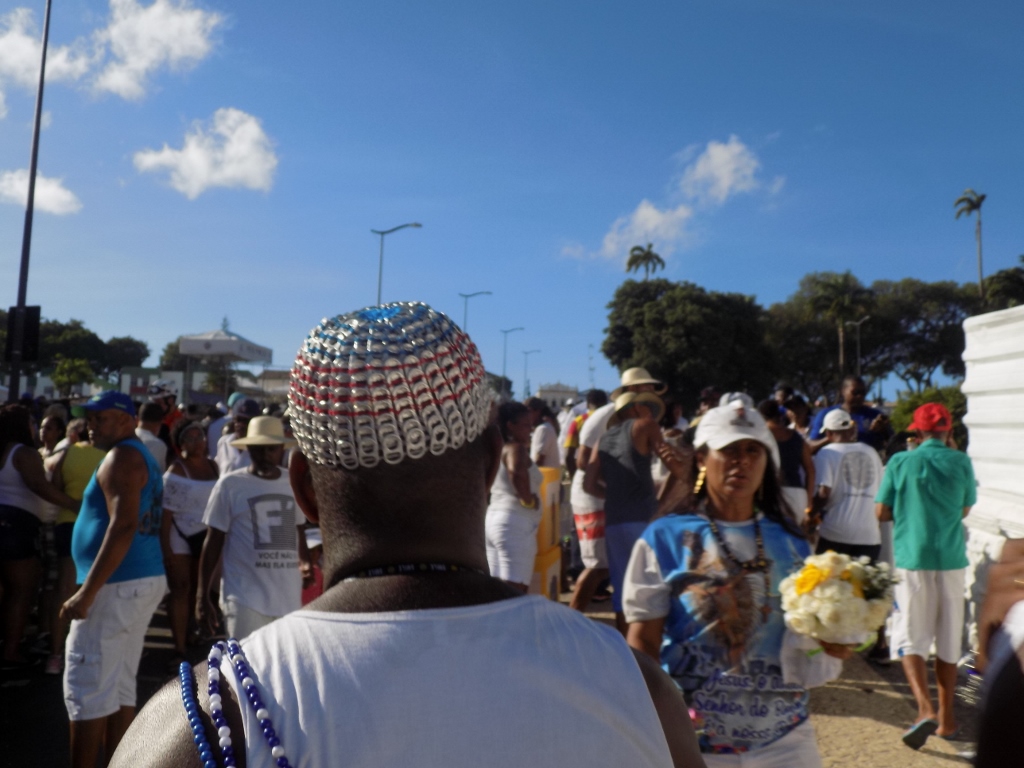 A cap made of soft drink can tabs
A cap made of soft drink can tabs
Then we finally approached the church. Taking into account the crowd that pressed around the church we did not even think of whether it was possible to get in and it certainly seemed closed.
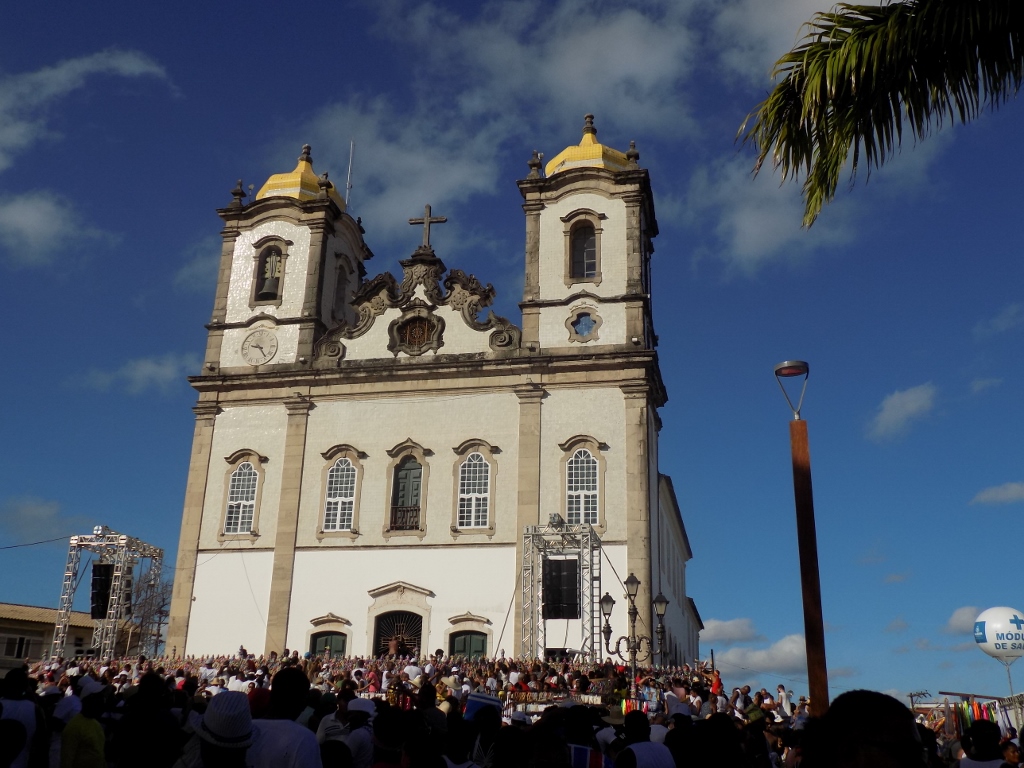 Church of Our Lord of Good End (Igreja de Nosso Senhor do Bonfim)
Church of Our Lord of Good End (Igreja de Nosso Senhor do Bonfim)
Around the church, there was a metal fence and it was full of countless coloured ribbons tied to the bars of the fence. These ribbons called fita are one of the symbols of Salvador and we were each given one such ribbon by the taxi driver who had taken us from the airport to the flat the day before. The ribbons are to be tied around a wrist and they serve as an amulet. It is necessary to tie three knots and wear it until the ribbon falls apart. Apparently, it is an extremely bad luck to cut it off. As it can be seen in the photos below, the ribbons may also be tied to the metal fence around the church, while some think that it is even better if they are tied to the metal door of the church.
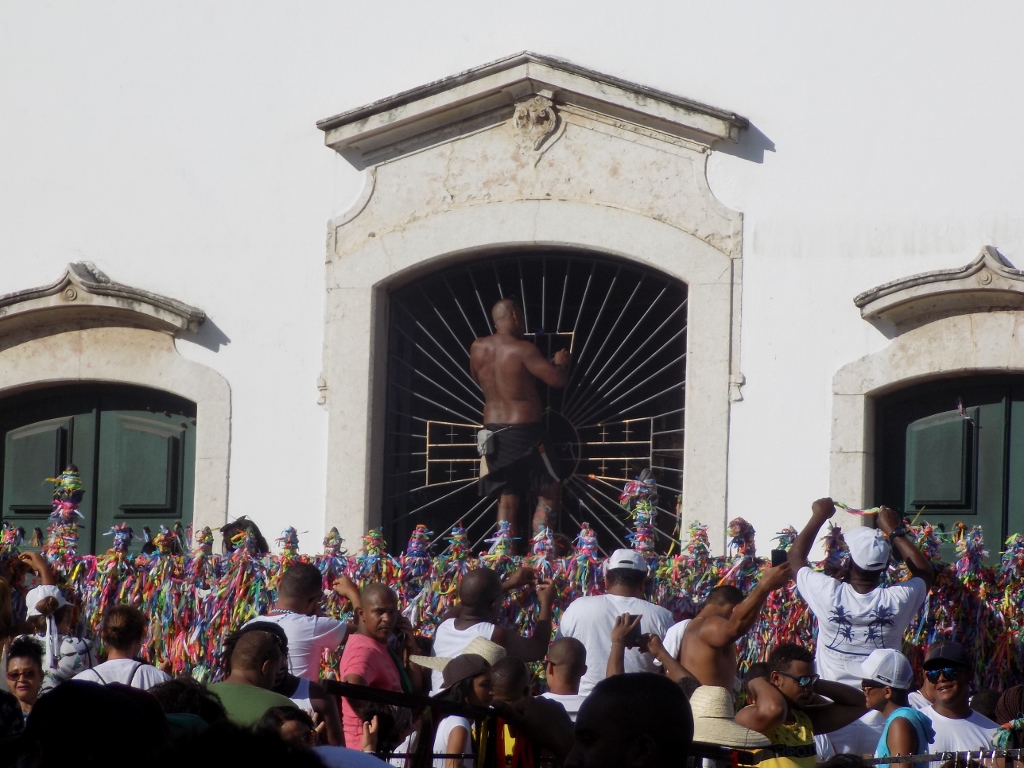 Tying of the amulet ribbons
Tying of the amulet ribbons
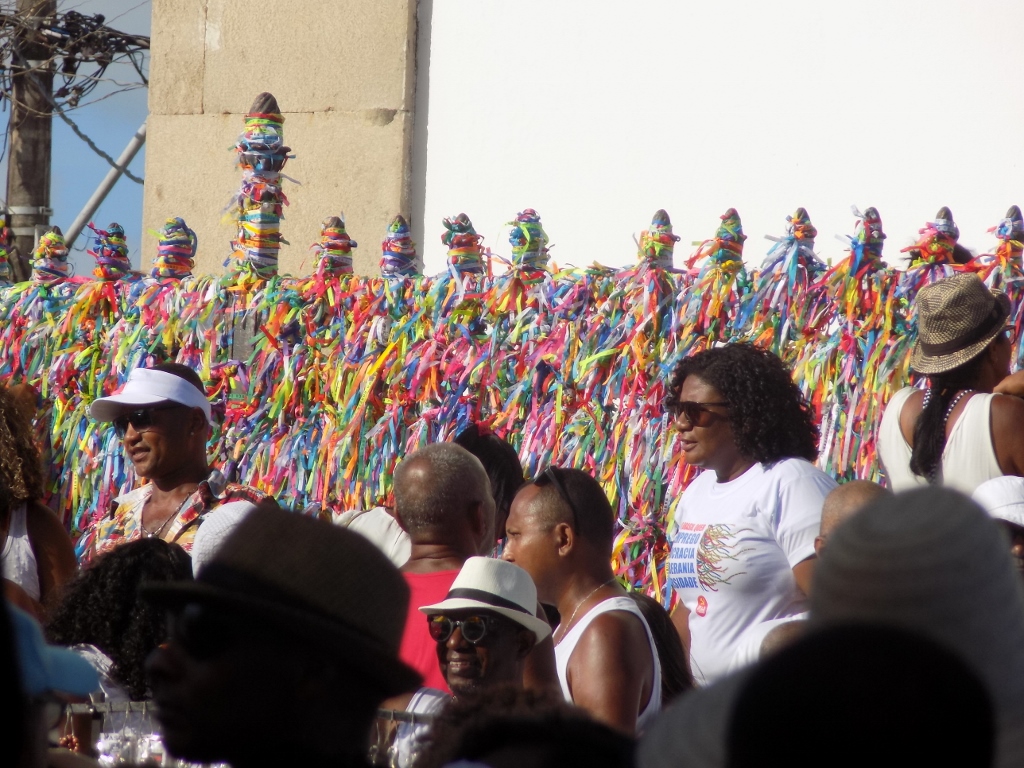 Amulet ribbons on the fence of the Church of Our Lord of Good End
Amulet ribbons on the fence of the Church of Our Lord of Good End
Now, have a look at all of this once again in the form of a short video clip.
Then we slowly returned to more or less the same place where the taxi-driver left us a little earlier. We were thinking of trying to return to the centre by bus or moto-taxi (you sit behind the motorcycle rider, which may make sense since it is easier for a motorcycle to move through a traffic jam), and some local women also tried to help us by calling a Uber-ride (they contacted them by local mobiles), but nothing really worked out and we eventually barely succeeded in catching a regular taxi. Still, before that I had a photo taken with those kind women who were sitting by a cross-road enjoying the celebration and beer.
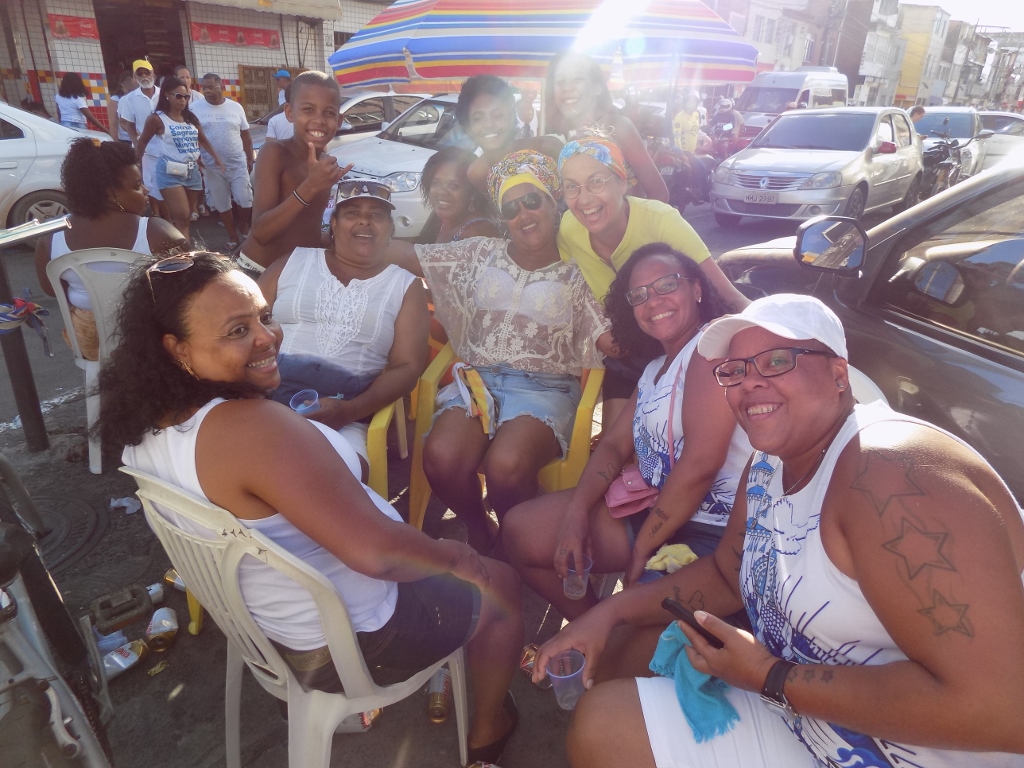 I also have a colourful hair-band
I also have a colourful hair-band
The return to the centre was also problematic. Again, there was a huge jam all over the place, the taxi tried to move through somehow and this taxi-driver was certainly less patient than the previous one. And yet, although we had agreed in advance on the fixed price for the return ride, it still took us around one hour to get to the destination of our choice.
And our destination this time was the public elevator, Elevador Lacerda, which like the funicular connects the lower and the upper parts of the downtown Salvador. There were still crowds in the street, the elevator ride was free of charge, like the funicular ride earlier, but now at least we knew the reason.
Close to the exit from the elevator, we passed by a confectionary which offered fantastic ice-creams. We took two scoops each and my main criterion was not to know what I was taking and I did not regret it. The ice-cream was great!
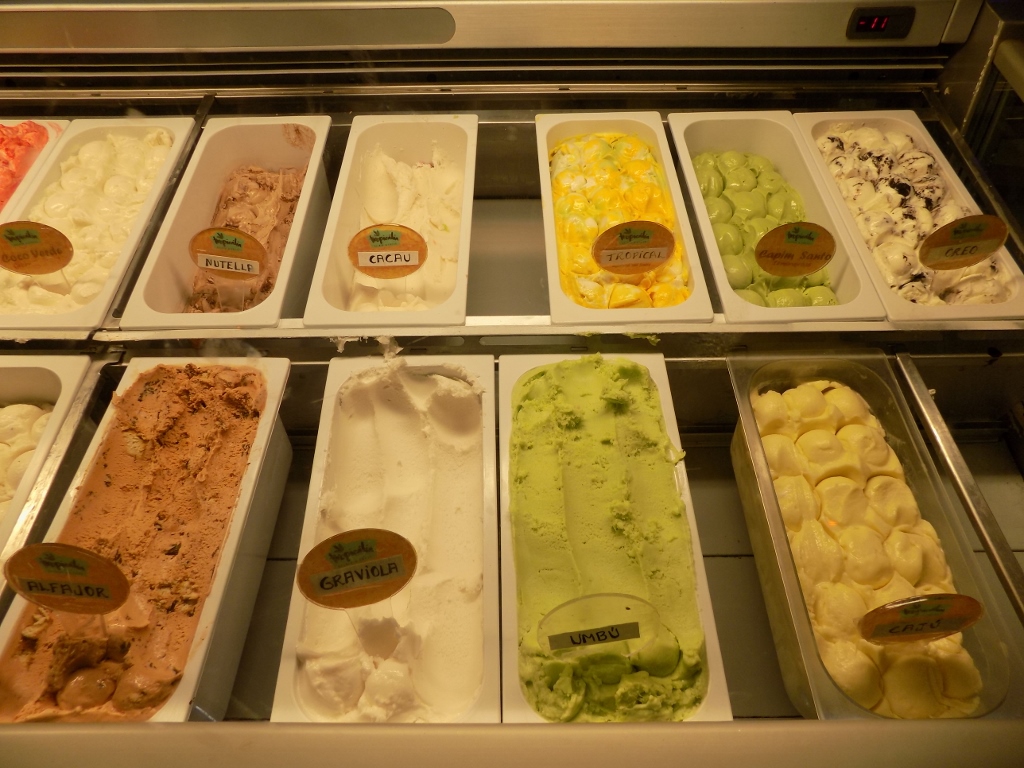 Ice-cream offer in the old part of Salvador
Ice-cream offer in the old part of Salvador
Now we felt significantly more relaxed and safer than the first evening, so we could truly enjoy our walk towards Carmo neighbourhood in which we had the rented flat.
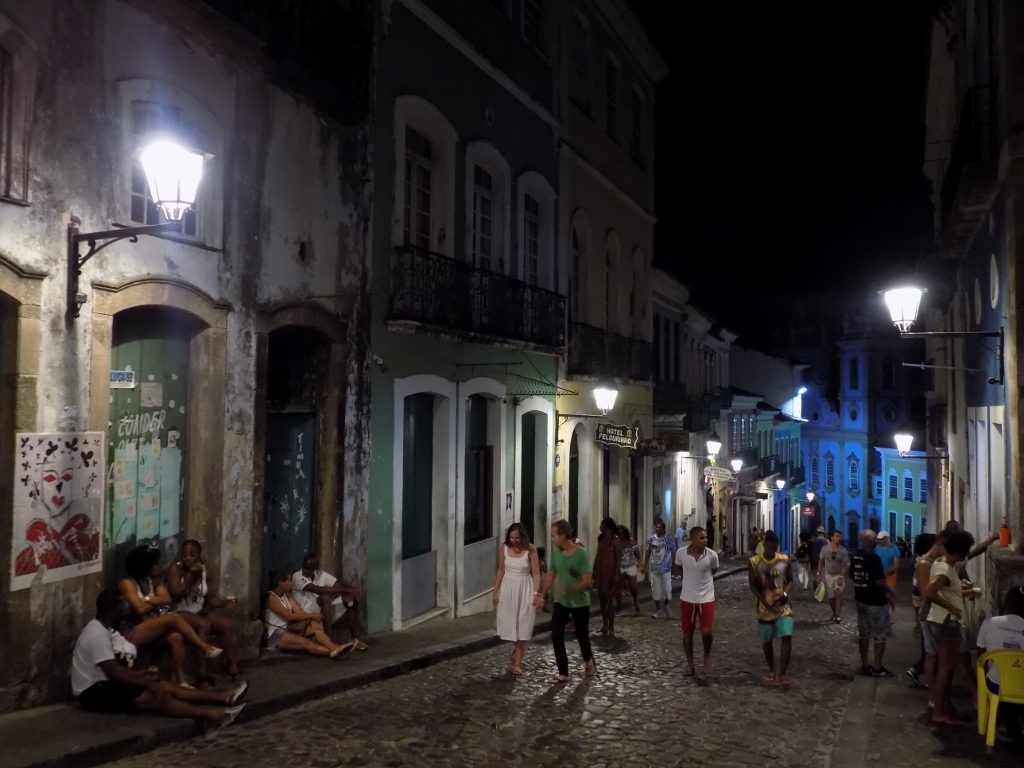 Centre of Salvador at night
Centre of Salvador at night
We even stopped at one of the different improvised “kitchens” in the open. The vendors simply put up all the necessary installations on the pavement in some places and plastic chairs around that “kitchen,” and then you sit there and eat the food that is prepared on the spot. Like when we were having lunch, we took again some grilled meat that was not bad at all, but later we saw that they also offered fried pastry with cheese that the two of us loved.
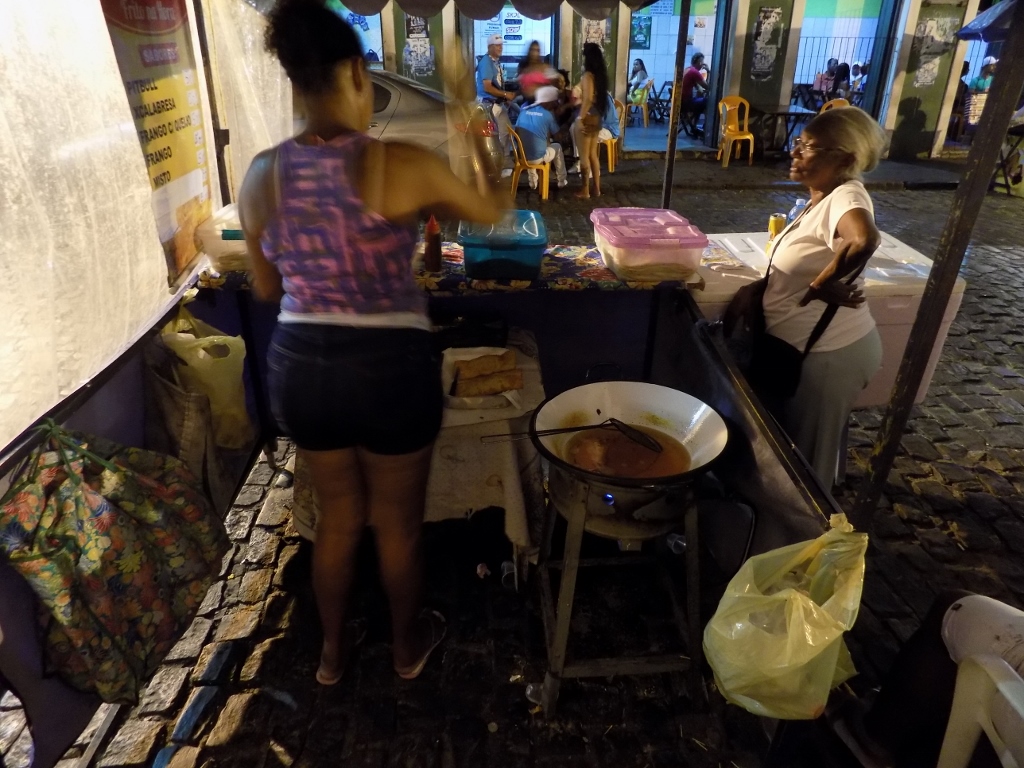 The kitchen is open
The kitchen is open
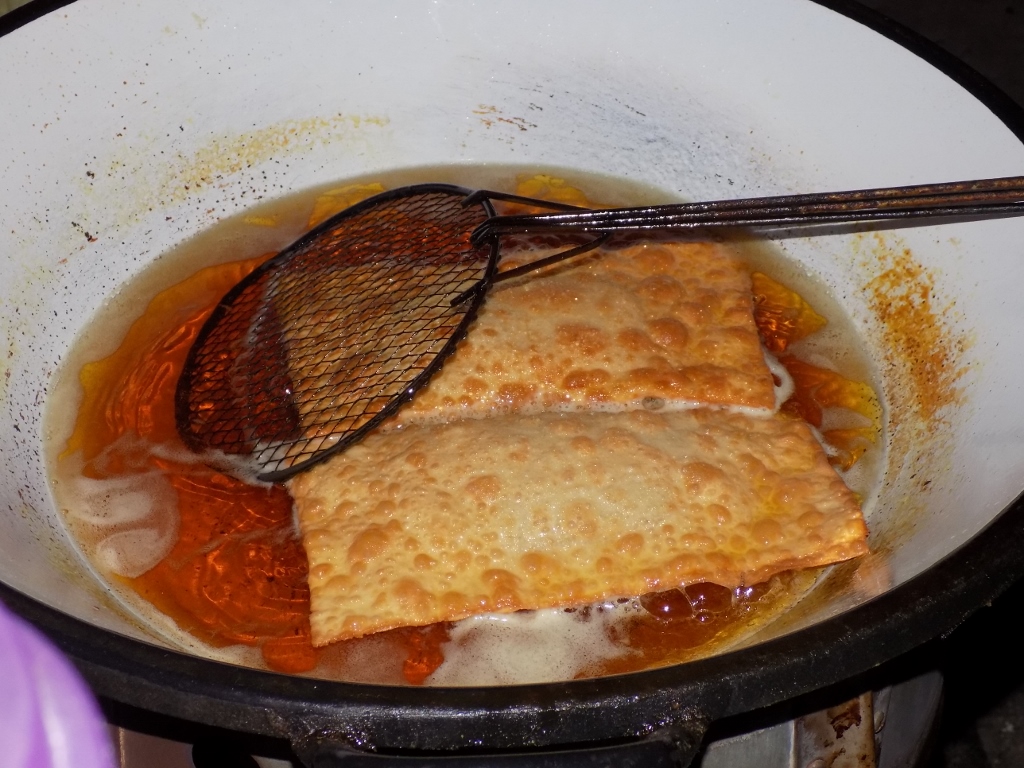 Fried pastry with cheese (Pastel de queijo)
Fried pastry with cheese (Pastel de queijo)
In our quarter we were greeted by loud music which was obviously resonating there the whole day. By now it was all completely clear to us and we had more understanding for the celebration of one of the most important local holidays. In addition, later, during the night, all did die out and one could sleep in peace.
For the following morning, I decided to walk once again to Pelourinho quarter, specifically to the terrace that exists next to the exit from the elevator, since there is a lovely view at the port from there. Along the way I enjoyed the wonderful sights that are abundant in Salvador, all the time turning back lest I should miss out on something pretty.
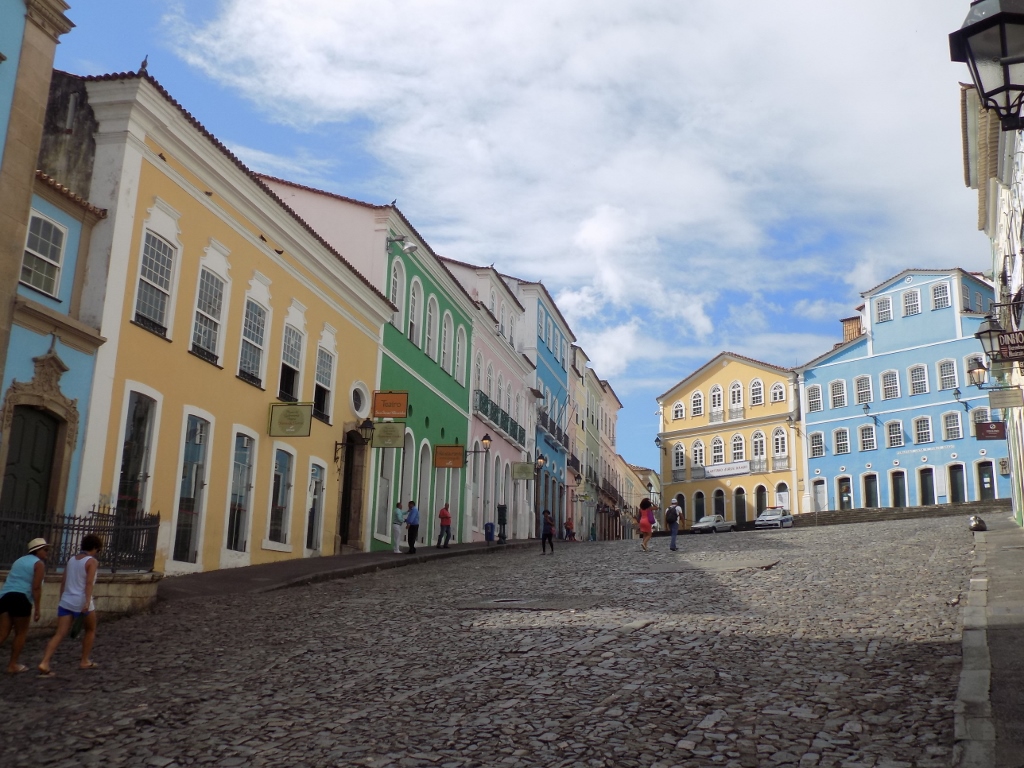 Largo do Pelourinho early in the morning
Largo do Pelourinho early in the morning
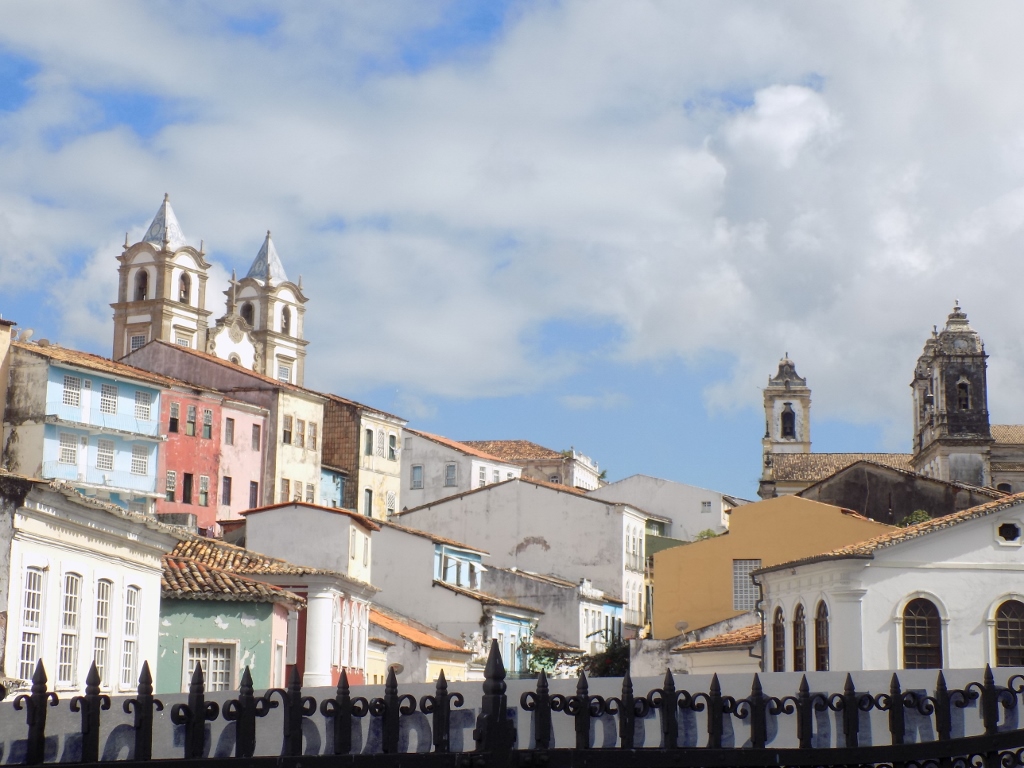 Carmo quarter: Church of the Blessed Sacrament at Rua do Passo to the left and the Church of the Third Order of Mount Carmel to the right
Carmo quarter: Church of the Blessed Sacrament at Rua do Passo to the left and the Church of the Third Order of Mount Carmel to the right
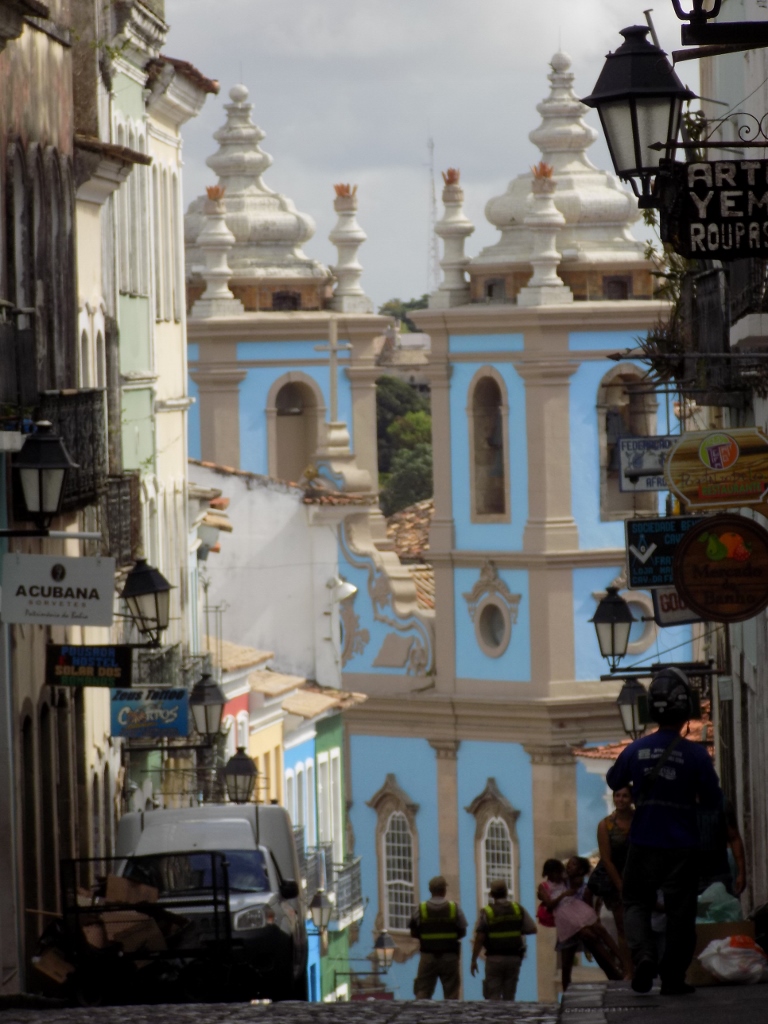 A steep street in Pelourinho and the Church of Our Lady of the Rosary of the Black People
A steep street in Pelourinho and the Church of Our Lady of the Rosary of the Black People
Having reached the terraces that are located by the exit from Elevador Lacerda, I looked at the Lower City for a while, but without any real desire to go down and walk there. Somehow, in my head, I was already ready to move on with my journey and therefore my sightseeing this morning consisted of only superficial gazing.
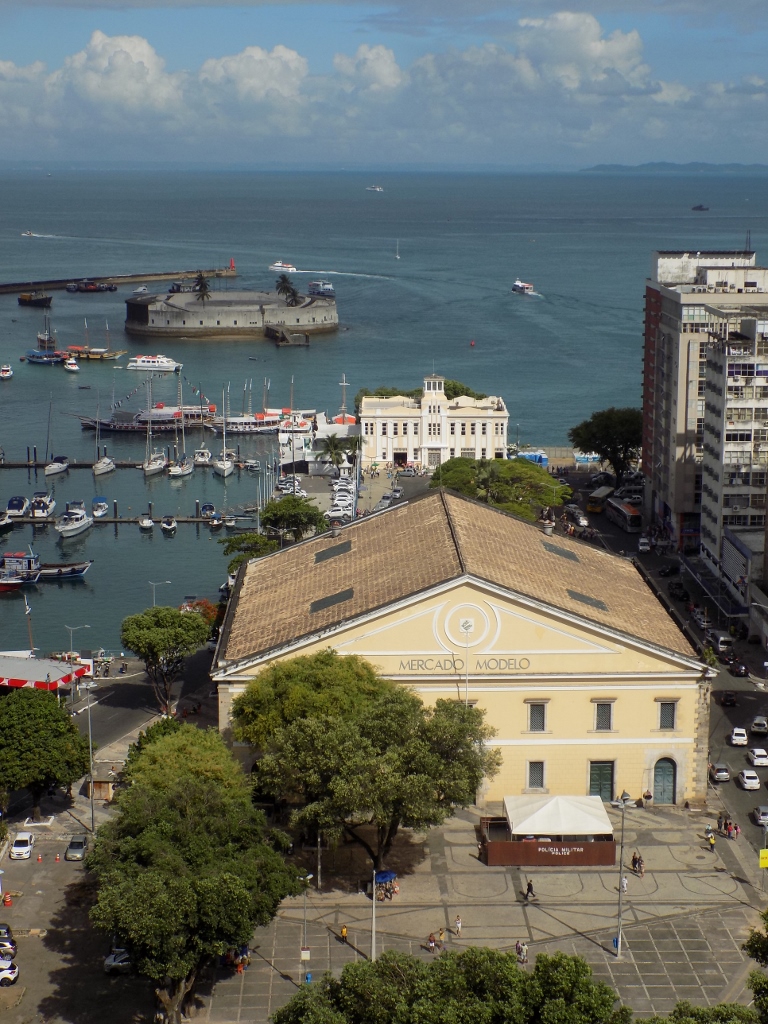 Lower City; among other things there is also São Marcelo Fort
Lower City; among other things there is also São Marcelo Fort
Around those terraces from which there is a fine view, there are local women who walk around in traditional dresses ready to have their photos taken by tourists against some fee. I was not really interested in that, but I found it funny that they turned their backs the minute they saw me walk around with a camera in my hand, so I decided not to disappoint them and to take a photo of them after all.
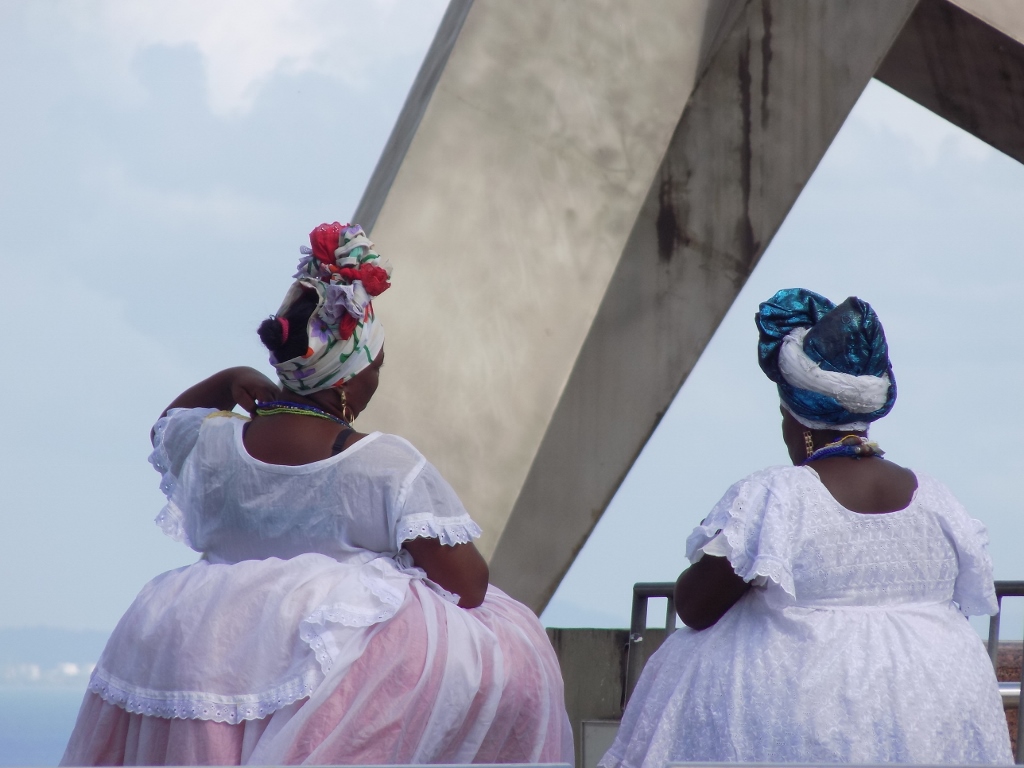 The costume is seen after all
The costume is seen after all
I have already mentioned Michael Jackson before and his video for the song “They don’t care about us” where in addition to the colourful Brazilian exteriors it is also possible to see drums and drummers in specific colours (black, yellow, red and green), while the singer himself often wears a t-shirt with a printed peace sign in these colours (the t-shirt is ripped in some of the scenes; I guess Michael Jackson did it while being immersed in the song). Anyway, it all concerns Olodum. Olodum was founded in 1979 as the African block for the carnival that takes place in Salvador. This is a non-governmental organisation that, among other things, fights against social discrimination, for the boosting of the pride amongst the Brazilians of African origin, and for the civil and human rights of marginalised people. Olodum is also the name of a large drummers’ band that has become world famous and that has played with different musicians. The seat of Olodum is precisely here in Salvador and I walked beside it. On the ground floor there is a shop with different things displaying the peace sign and in the said colours and whoever wants may buy a t-shirt and rip it up to their heart’s content.
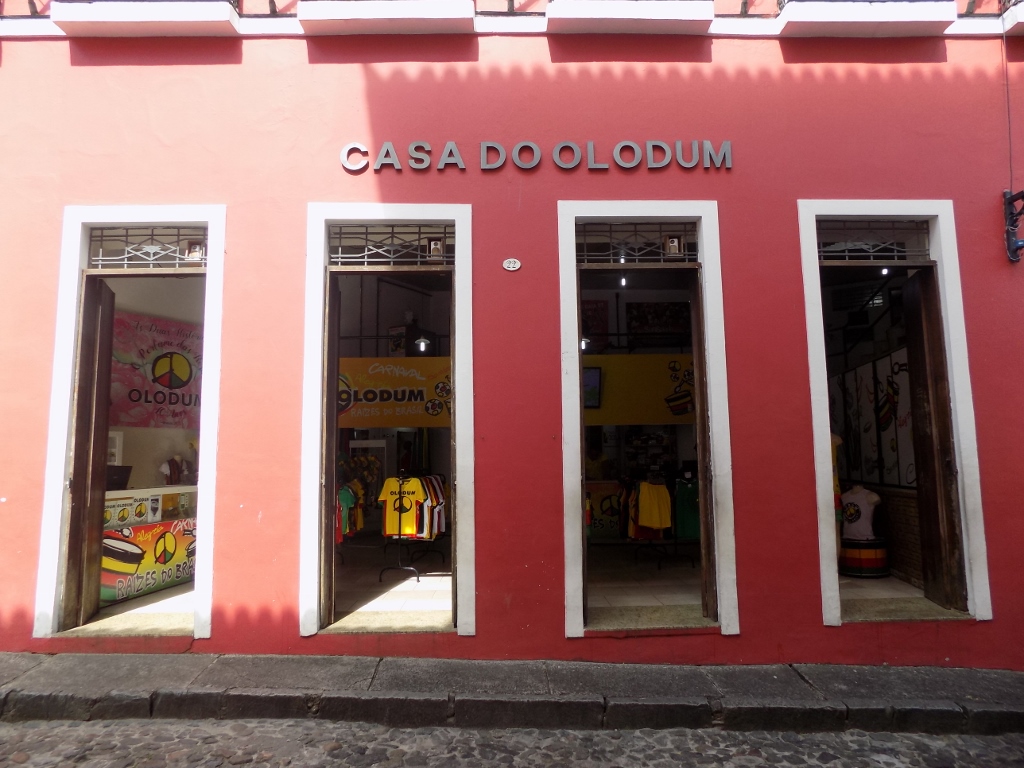 House of Olodum
House of Olodum
I also walked past the seat of the organisation “Children of Gandhi” (Filhos de Gandhy) and I could not help myself and had to take a peek inside.
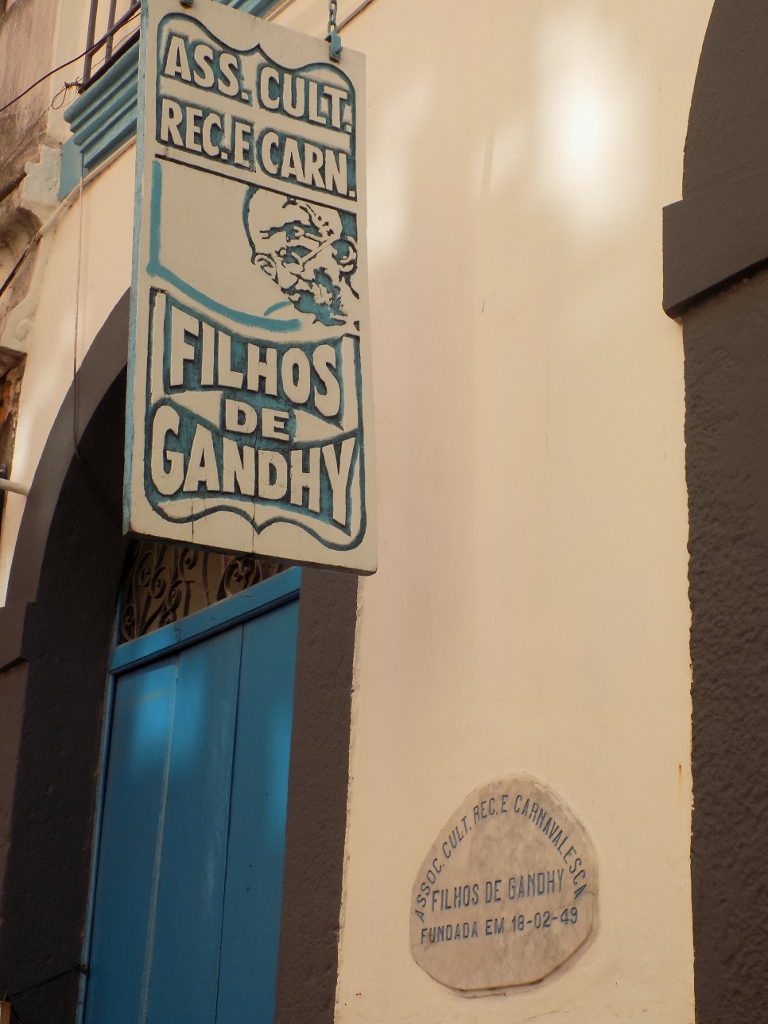 “Children of Gandhi”
“Children of Gandhi”
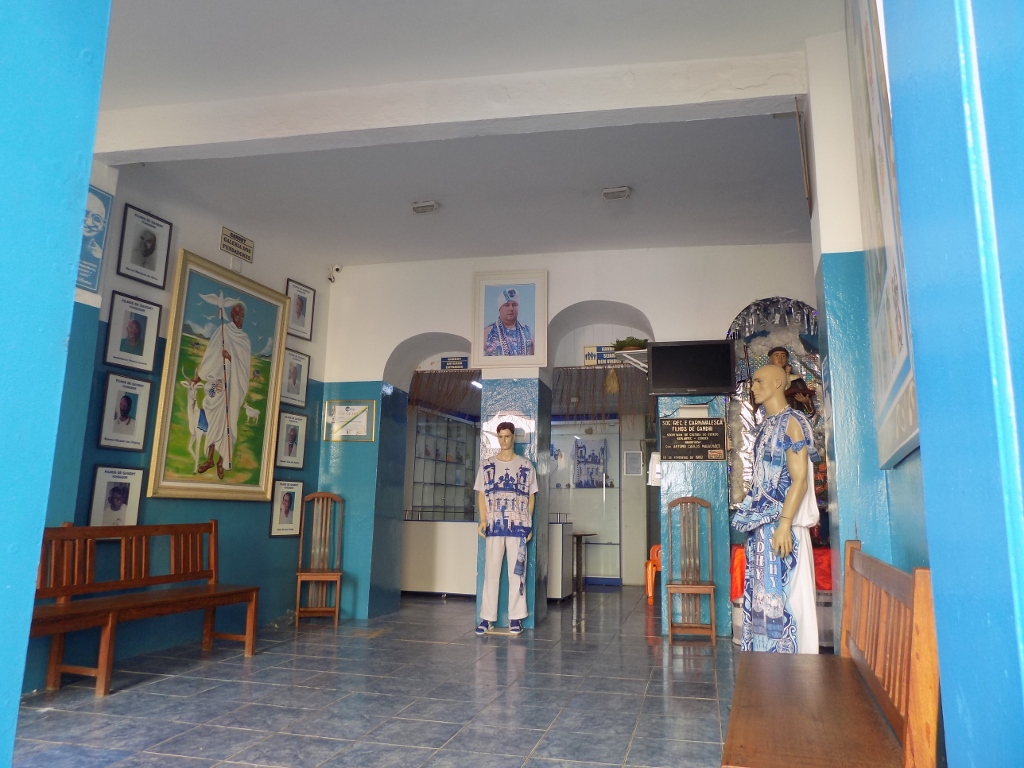 “Children of Gandhi,” view from the street
“Children of Gandhi,” view from the street
A little bit more of admiring the beauties of Salvador and I was ready to go back to the flat in order to have breakfast.
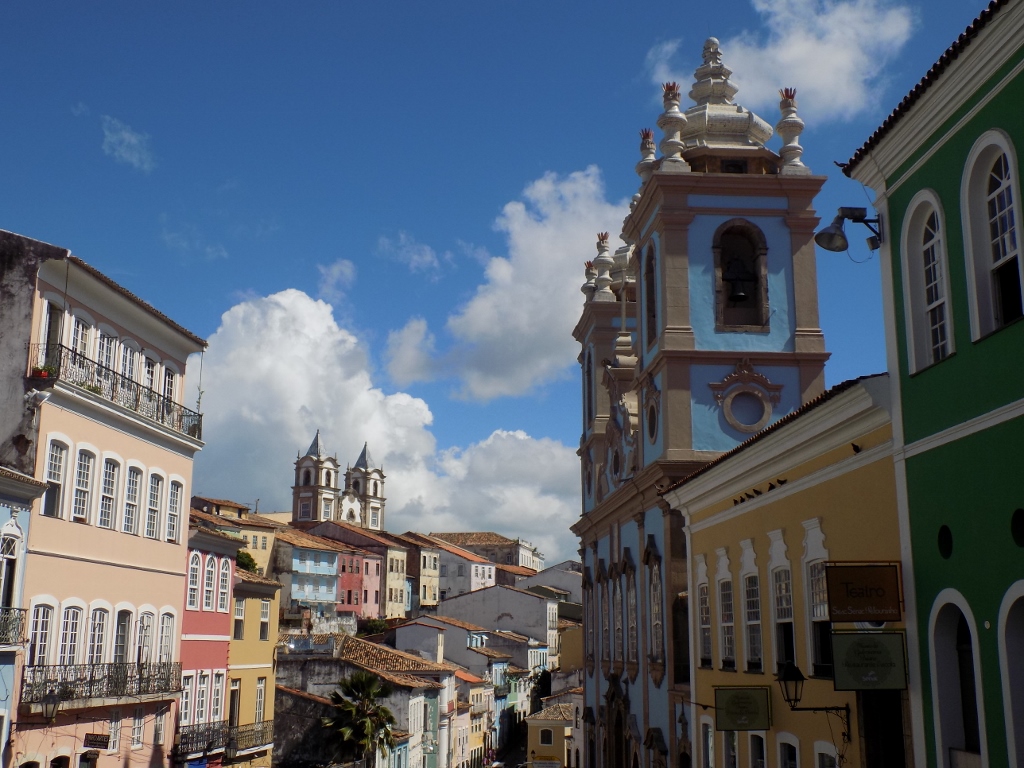 Church of the Blessed Sacrament at Rua do Passo is to the left, while the Church of Our Lady of the Rosary of the Black People is to the right
Church of the Blessed Sacrament at Rua do Passo is to the left, while the Church of Our Lady of the Rosary of the Black People is to the right
After the breakfast, packing up and getting organised, we could move. This day, we took a coach to transfer to the city of Aracaju. It is also on the coast, north of Salvador and it takes a coach around 5 hours to cover the distance between these two cities.